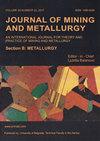含碳铁熔体中FeCr2O4还原的动力学机理
IF 1
4区 材料科学
Q3 METALLURGY & METALLURGICAL ENGINEERING
Journal of Mining and Metallurgy Section B-Metallurgy
Pub Date : 2023-01-01
DOI:10.2298/jmmb230215010x
引用次数: 0
摘要
铬铁矿直接合金化铬因其节能、工艺简化等优点而受到广泛关注。了解铬铁矿的主要成分FeCr2O4还原铬合金化,是了解铬铁矿合金化铬机理的关键。研究了熔体成分(加碳、加铬)和温度对含碳铁熔体还原FeCr2O4的影响。熔体中碳含量越高,铬的回收率越高。同样,较高的温度也有利于FeCr2O4的还原。由于碳与铬之间存在强烈的吸引力,碳的活性较低,因此添加铬阻碍了FeCr2O4的还原。研究了铁熔体中碳溶解还原FeCr2O4的动力学,结果表明,控制步骤是1823K时FeCr2O4/熔体界面处的化学反应。计算得到该反应的活化能为392.82 kJ/mol。本文章由计算机程序翻译,如有差异,请以英文原文为准。
Kinetic mechanism of FeCr2O4 reduction in carbon-containing iron melt
Direct alloying of chromium by chromite attracts a lot of interest for its superiority in energy-saving and process simplification. The knowledge of chromium alloying by reduction of FeCr2O4, the main component of chromite, is key to understanding the mechanism of chromium alloying from chromite. The effect of melt composition (carbon and chromium addition) and temperature on the reduction of FeCr2O4 by carbon-containing iron melt was studied. The higher the carbon content is in the melt, the higher chromium recovery is obtained. Similarly, the higher temperature is favourable for the reduction of FeCr2O4. The reduction of FeCr2O4 was impeded by chromium addition due to the lower activity of carbon resulting from the strong attraction between carbon and chromium. The kinetics of FeCr2O4 reduction by carbon dissolving in iron melt were investigated, and the results indicated that the controlling step is the chemical reaction at the FeCr2O4/melt interface at 1823K. And the calculated activation energy for the chemical reaction is 392.82 kJ/mol.
求助全文
通过发布文献求助,成功后即可免费获取论文全文。
去求助
来源期刊
CiteScore
2.00
自引率
40.00%
发文量
19
审稿时长
2 months
期刊介绍:
University of Belgrade, Technical Faculty in Bor, has been publishing the journal called Journal of Mining and Metallurgy since 1965 and in 1997 it was divided in two independent journals dealing with mining and metallurgy separately. Since 2009 Journal of Mining and Metallurgy, Section B: Metallurgy has been accepted in Science Citation Index Expanded.
Journal of Mining and Metallurgy, Section B: Metallurgy presents an international medium for the publication of contributions on original research which reflect the new progresses in theory and practice of metallurgy. The Journal covers the latest research in all aspects of metallurgy including hydrometallurgy, pyrometallurgy, electrometallurgy, transport phenomena, process control, solidification, mechanical working, solid state reactions, materials processing, surface treatment and relationships among processing, structure, and properties of materials.

 求助内容:
求助内容: 应助结果提醒方式:
应助结果提醒方式:


